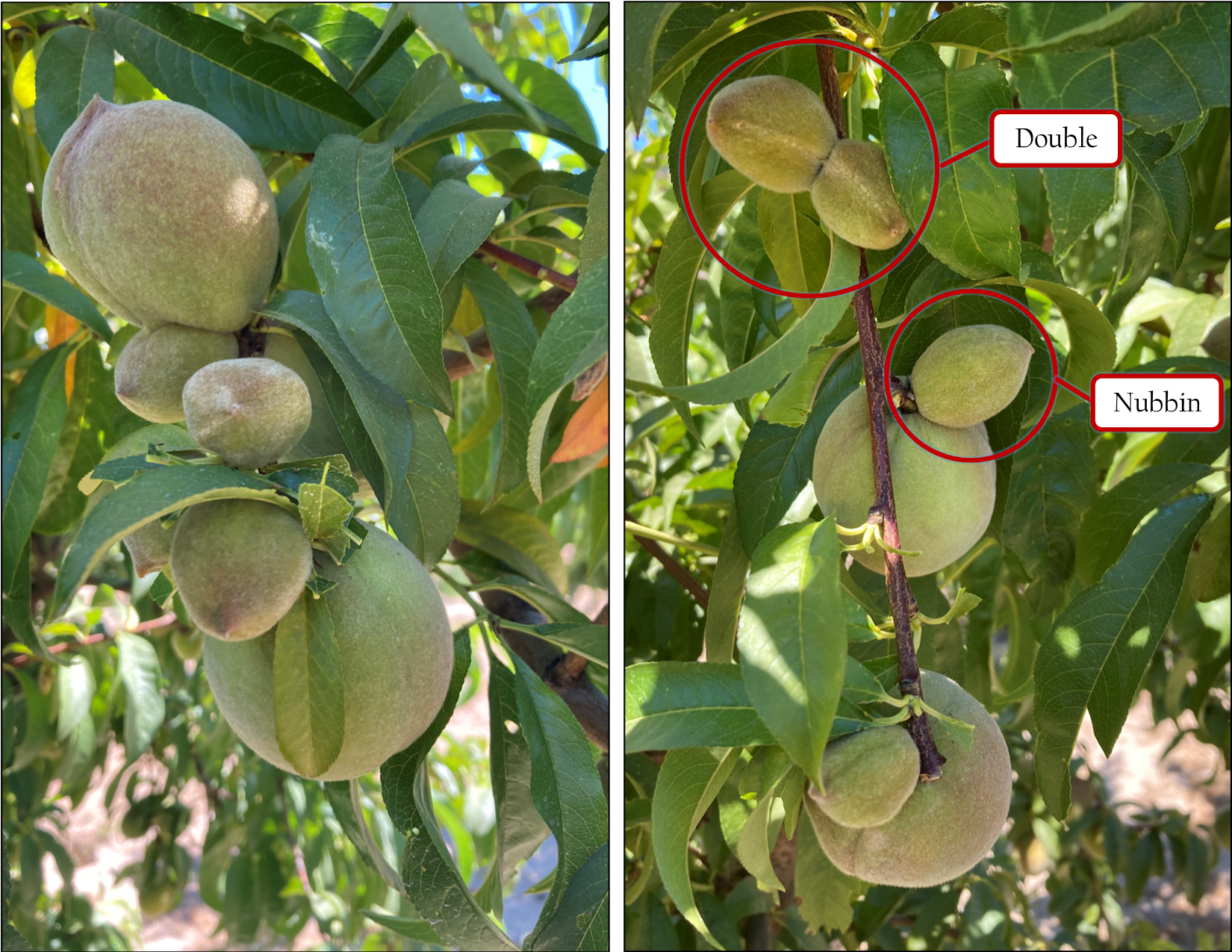Nubbins and Doubles on Peaches: Potential Causes
Cameron Zuber, Orchard Crops Farm Advisor, Merced and Madera Counties
Roger Duncan, Pomology Advisor, Stanislaus County
Maxwell Norton, Farm Advisor Emeritus
Occasionally smaller sized fruits are seen on the same variety of peaches midway through the growing season. When a single small fruit is at the peduncle, it is called a nubbin, meaning small lump or residual part (also called a dummy if one thinks the fruit is not smart enough to grow). If fruits are paired and fused at the peduncle, then they are typically called doubles or twins. A peach orchard in northern Merced County recently showed signs of both nubbins and doubles, which presents an opportunity to describe the potential causes for each.
Photos of ‘Fairtime’ peach variety in June 2022 from an orchard in northern Merced County with nubbins and doubles present along with larger maturing fruit (original photo source Maxwell Norton).
The orchard was in sandy soil and irrigated with double lines of drip irrigation. In June 2022, nubbins and doubles were present on the fifth leaf ‘Fairtime’ variety on Guardian rootstock, but not present on the other varieties in the orchard and no nubbins or doubles were observed the prior year. The occurrence of both is odd as there are different potential causes for nubbins and doubles.
Low Dormant Chill
In 2015, low chill accumulation was suspected to cause nubbins for peach orchards in and around Stanislaus County. The nubbins were widespread with ‘Fairtime’ varieties which are known for their susceptibility to low chill periods during dormancy. However, while the dormant period of 2014/2015 was characterized as low chill, the more recent period of 2021/2022 was not.
Photos of ‘Fairtime’ peach variety in September 2015 (left, photo source Roger Duncan) and June 2022 (right, photo source Maxwell Norton) with nubbins present.
Freeze
Another cause for nubbins could be freeze damage. When checking the interior of the nubbins, the area where the kernel forms was empty with only a small black speck present. This indicated that fertilization was not successful or the embryo was killed after formation. This was most likely due to a frost event, as a pollinated ovary could be killed from low temperatures during or after the bloom period. Unlike almonds which drop fruit without a viable kernel, peaches may stay on the tree to ripen normally but stay small.
Photos of nubbins collected from ‘Fairtime’ peach variety in June 2022 (collected by Maxwell Norton). Photos include intact nubbins (top left), cut opened nubbins (bottom left), and closer photo of nubbins’ interior (right).
Water stress
While low chill and frost are connected to nubbins, this has not been connected to doubles. The primary cause of doubles in peaches is attributed to water stress experienced during the previous year when flower buds are initially developing. In California, doubles are more closely tied to water stress in late summer, after harvest, when irrigation may have been reduced to save water. 1,2
Another peach orchard in northern Stanislaus County had a few spurs with doubles present on the ‘Ross’ variety in July 2022; however, running out of water was not suspected in this case. The fruits were small and when pulled apart were connected near the peduncle end. The connection area seemed to go from the exterior of the fruit to the outer layer of the shell. However, there was still a formed kernel inside the shell unlike the fruit from the Merced County orchard.
Photos of double collected from ‘Ross’ peach variety in July 2022 (collected by Maxwell Norton). Photos include double looking at peduncle end intact (top left) and pulled apart (top right), double looking at suture intact (bottom left), and interior of one double with connection area and formed kernel (bottom right). Damage to kernel due to knife when cutting open fruit.
For the peach orchard in northern Merced County, the presence of nubbins and doubles is most likely due to a combination of the factors mentioned prior and possibly others. Unfortunately, the effects of environmental conditions and irrigation can be seen much later than when it occurred. For peaches, factors can affect your crop during the latter half of the growing season when buds are developing, through dormancy, and around bloom. Understanding which factors to be aware of allows for appropriate management decisions.
For resources relating to chill visit the Fruit and Nut Research and Information Center here, for different strategies of frost protection please listening to this episode of the Growing the Valley podcast, and for considerations relating to drought irrigation strategies please visit UC Drought Management here.
1D. F. Handley and R. S. Johnson. 2000. Late summer irrigation of water-stressed peach trees reduces fruit doubles and deep sutures. HortScience 35:771.
2R. S. Johnson and D. F. Handley. 2000. Using water stress to control vegetative growth and productivity of temperate fruit trees. HortScience 35: 1048-1049.




